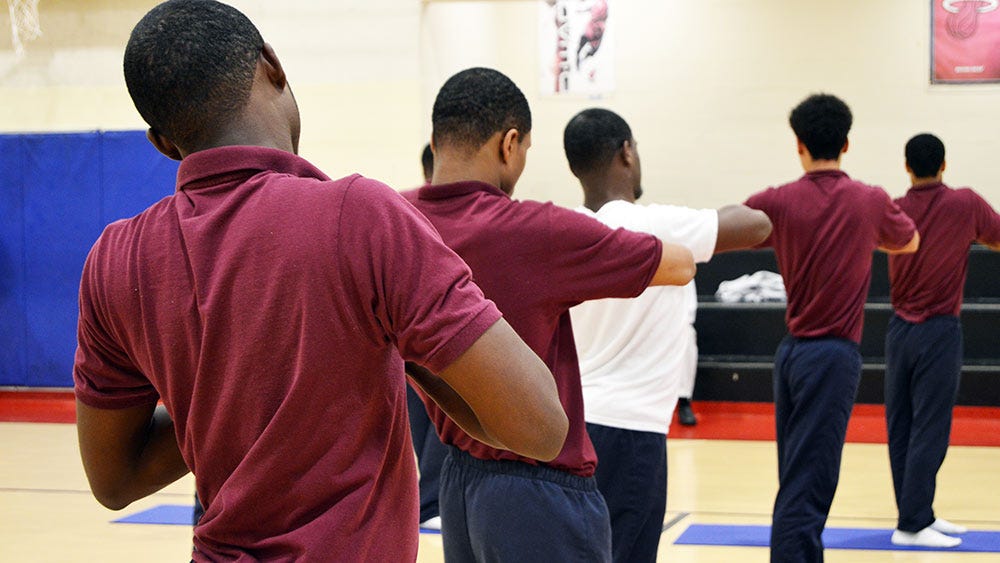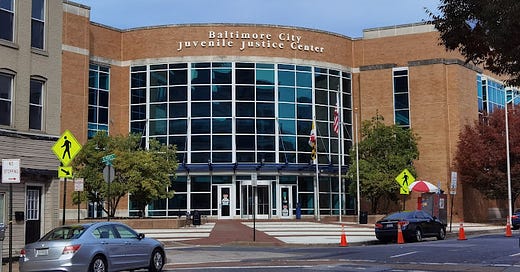BALTIMORE OBSERVED: We have failed juvenile offenders for four decades. Too Often, Once They Get Locked Up, We Lose Them For Life.
Md. pays hundreds of thousands of dollars a year to keep one juvenile locked up, often a nonviolent offender, most often, a child of color, deprived of even basic education while incarcerated.
In my hometown, kids have made me cry, more than a few times, since I covered city schools for The Baltimore Sun in the 1990s — not in front of them, but deep in the night, when I could still see their tears in my mind’s eye, hear the echo of their stories and sometimes their sobs: the horrors they see that no child should ever witness, the heartbreak they know that I could not imagine enduring, watching mothers and fathers and classmates and teammates being shot, being harassed and demonized by police by age 10, being deprived of a decent school, a rec center, a safe playground, sidewalks where you can stroll and just be a kid instead of hearing gunfire every night.
But I also recall students who astounded me — the former, gun-toting gang member who, with the help of an innovative, Abell Foundation-supported program called “Futures” graduated as an honors student and went on to college. I recall, too, other innovations I covered like the partnership between the Barclay School, where almost all students were poor children of color, and the elite Calvert School. The Barclay-Calvert partnership proved that with the right ingredients, in this case, a rigorous curriculum the Barclay principal followed to the letter, an urban educational miracle can happen. I’ve also interviewed kids who watched loved ones shot to death and somehow found a way to smile again and seek to help others who suffered such unspeakable grief.
They’re heroes to me.
We need more faith in children not only, but especially, when they make mistakes, more faith in their resilience, their toughness, the magic that happens when you set high standards, believe in them and make clear to them that you have no doubt they got this. They can succeed.
Back to juvenile justice.
We just hit a 10-year high in total shootings and fatal shootings of youths 19 and under in my hometown. It’s getting harder to grow up here in too many ways, if you’re a poor child of color, in particular.
Our juvenile justice system has failed generations of juvenile offenders.
As they say in 12-Step groups, “If nothing changes, nothing changes.”
I refuse to give up on much of a generation because we have failed them as much or more as they failed us because we decree that they fell short, and write them off.
I count myself blessed to have worked two years for the nonprofit Juvenile Justice Information Exchange (but did allow in conversations with my editor that his boss, the publisher, picked about the least sexy name for a publication imaginable).
Fundraising reasons, then-Editor Extraordinaire John Fleming, a former star foreign correspondent for Reuters, explained.
Reporting for JJIE taught me so much I never thought I needed to know, but came to realize it’s what we ALL need to know — if we’re to save our city, for to do so, we must save our youth.
We have failed them utterly as a city and a nation, for decades.
The juvenile justice system is among the worst culprits in ruining troubled kids’ lives forevermore. Juvenile incarceration is, in fact, the No. 1 predictor of adult incarceration. The system, with some notable exceptions (and they are growing through meaningful reform) still routinely warehouses kids, depriving them of even basic education. At its worst, it sometimes brutalizes them physically and mentally.
We need to stop treating them this way. We need to stop judging young offenders — and measuring their worth — mainly by what they did in their worst moments. For all the talk of rehabilitation — the ostensible reason for the existence of the juvenile justice system — it remains mostly a cruel myth.
We pay a fortune for this hideously ineffectual system — from around $200,000 per year to incarcerate a single juvenile offender (in FY 2022) to $507,000 a year per youth at the Victor Cullen Center in Frederick County.
In Maryland youth detention centers, violence continues routinely — fights, occasional abuse of kids by those charged with protecting them. Some 40% of youths locked up after being adjudicated for nonviolent offenses, even loitering or public drunkenness.
Please consider supporting independent, fearless, tireless reporting by clicking here to contribute to The Baltimore Observer.

Yet hope grows in juvenile justice, if only we’ll believe young offenders are not done for life because of what they did before becoming adults.
We need to always look for flickers of hope — to figure out what’s working, far and near, and what’s worthy of emulating — and I’m a big believer in the Solutions Journalism movement.
So I relished reporting for JJIE on good news out of detention centers through “family engagement.”
Might not sound like much, but it’s made all the difference for a helluva lot of kids.
This is all about a radically different way of viewing these youths.
In Maryland, we’re seeing some small victories playing out in juvenile facilities more frequently, things other kids take for granted: yoga sessions; a nonprofit bringing in piles of books to locked-up kids across the state, and, yes, they love reading, most of them; a new program that gets juvenile offenders out in the fresh air, while making $13.25 an hour, Maryland’s minimum wage, as interns for the state Department of the Environment.
More importantly, the state’s new juvenile justice chief, Vincent N. Schiraldi, says he’ll greatly expand the state’s efforts to shift money from massive juvenile prisons into communities for job-training, rec centers, after-school programs, social services and mental health treatment, including for kids haunted by trauma.
Schiraldi, a legend in juvenile justice circles as a results-driven reformer, also pledges to continue slashing the numbers of kids who end up behind bars by offering instead innovative programs to help them find a better path. Known for candor, not always welcome, Schiraldi would be the first to tell you we need to radically rethink and then reinvent the state’s juvenile justice system.
![[photo, Vincent N. Schiraldi, Maryland Secretary of Juvenile Services] [photo, Vincent N. Schiraldi, Maryland Secretary of Juvenile Services]](https://substackcdn.com/image/fetch/$s_!g57N!,w_1456,c_limit,f_auto,q_auto:good,fl_progressive:steep/https%3A%2F%2Fsubstack-post-media.s3.amazonaws.com%2Fpublic%2Fimages%2F9ceb96cc-d04c-48e8-b601-130cae07d687_180x250.jpeg)
We’re only as good as our sources, and I learned so much from Bart Lubow, then nationally renowned juvenile justice director at the Annie E. Casey Foundation, and his successor, Nate Balis. I also count among trusted sources, which is to say teachers, dozens of juvenile justice advocates dedicated to forcing the system to live up to its stated mission: not to punish, but to rehabilitate youths.
Author Nell Bernstein and New Yorker writer Jennifer Gonnerman gave me long interviews, after I read their works closely, that proved to be among the most fulfilling, educational and painful I’ve done in nearly four decades as a journalist. I did a story that will always stay with me on a prisoner sentenced to juvenile life without parole through a juvenile justice reporting fellowship from the John Jay College of Criminal Justice. I interviewed often some of the most highly regarded reformers in juvenile justice circles, including Schiraldi.
He took over as secretary of the Maryland Department of Juvenile Services in February, and he may be the best hope for finally getting it right by juvenile offenders in Maryland. Schiraldi’s already brought in a team of top juvenile justice advocates like Marc Schindler, who comes to DJS from the Justice Policy Institute, a national nonprofit dedicated to reforming the juvenile and criminal justice systems.
All children deserve a legitimate shot at turning their lives around, and we owe them that chance, to reach out to them wherever they are; to try to lift them up when we can instead of tearing them down; to see beyond what they have been at their worst, most desperate moments, to what they can become, and what they can overcome.
I believe in second chances. I believe in redemption. I believe we can save them, so many more of them.
But then who am I to preach as if I’m an editorial writer if I don’t try to do something to help at least some of these kids in some small way?
So I’m going to try, by applying what I’ve learned from, and taught to, hundreds of students as an adjunct journalism faculty member at my alma mater, the University of Maryland, College Park, and Loyola University Maryland.
I hope to tap into ex-juvenile offenders’ street smarts, the lessons they learned about how easily kids can lose their way, then give them some advice, some questions to ask, suggestions on who might answer them.
They can take it from there, heading out with a notebook and pen to report stories as interns for The Baltimore Observer.
Thanks for reading The Observer, Baltimore.




